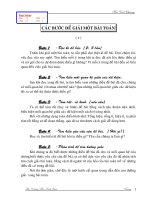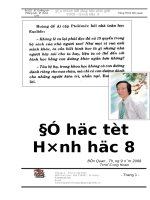TAI LIEU BD HSG (TIPS ON TEST TAKING)
Bạn đang xem bản rút gọn của tài liệu. Xem và tải ngay bản đầy đủ của tài liệu tại đây (47.45 KB, 2 trang )
ERROR CORRECTION
TIPS ON TEST TAKING
A> GUESSING WORDS IN CONTEXT
Find out and correct 15 errors in the following passage
Once we know around two or three thousand word we can use the reading
skills we have developed to infering the meanings of unknown words that we meet.
Some of us can do this with any particular training, but those who cannot do it can be
taught a strategy, which will enable us to guess most of the unknown words they
meet.
The strategy is basical very simple. It begins by getting the learner looking
closely at the unknown word, next to look for its immediate context, and then to take
a much broader view of what the clause containing the word relates to other clauses,
sentence or paragraphs.. Before guessing, there is a system of check to make sure
that the guess is the best possible. The unknown word must be syntactically,
semantically, and stylistically acceptance. Once learners have mastered the steps of
the strategy then have practised guessing words by systematically go through the
steps, it is no longer to apply whole the steps. That is, the strategy is just a mean of
acquiring the unconscious skills that an efficient reader already has
HOW TO APPLY THESE STEPS IN THE CLASS
The various steps need in the strategy can be practised separate before being
combined into a strategy. The guessing strategy can be used in co-operative class
exercise or for individual work such as homework. After the strategy is being
introduced the teacher can demonstrate the steps to the learners use the word from
the passage. The steps are putting up on the board. Then one word is chosen on the
passage for the whole class guessing. The teacher then called on different learners
to do each steps. So one learner has the task of saying what part of speech the word
is, and then others looks at the immediate grammar of the word, and so on. After
doing a few word like this the learners can work in pairs and then on their own.
Guess words in context may lead on to dictionary work. If the learner already has a
reasonable idea of what means he will be unable to choose the most suitably
meaning from those given in the dictionary
1
Find out and correct 30 errors in the following passage
THE STEPS INVOLVING IN THE STRATEGY
1. Read the whole text to have the global idea of the passage and to identify the
reader (audience) what is important to choose the right words.
2. Look at the unknown word and decided its part of speech. Is it a noun, a verb, an
adjective or an adverb ?
3. Look at the clause or sentence contain the unknown word. If the unknown word is
a noun, what adjective describes it ? What verb is it near? That is what does noun
does and what is doing to it. If the unknown word is a verb, what noun does it go
with? Is it modifying by an adverb? If it is an adjective, what noun does it go
with? If it is an adverb, what verb is it modified?
4. Look at the relationship among the clause and sentence containing the unknown
word and another sentences or paragraphs. Sometimes this relationship will be
signal by a conjunction as but, because, if, when, or by an adverb like however,
as a result. Often there will be no signal. The possibly types of relationship
includes cause and effect, contrast, inclusion, times, exemplification, and
summary. Punctuation may also serve as a clue. Semicolons often signal a list
with inclusion relationships, dashes may signal restatement. References words
like this, that, such also provides useful information.
5. Use the knowledge you have gained from 2 – 4 guessing the meaning of the
word.
6. Check that you guess is correct.
a. See that the part of speech of your guess are the same as the part of speech of the
unknown word. If it is not the same, then everything is wrong with your guess.
b. Replacement the unknown word with your guess. If the sentence makes sense,
your guess is possible correct.
c. Break the unknown word onto its prefix, root and suffix, if possible. If the
meanings of the prefix and root corresponds to your guess, it is good. If not, look
at your guess against, but do not change anything if you feel reasonable certain
about your guess used the context. Experience has shown that using affixes and
roots alone as a mean of guessing meanings is not very reliable.
2









